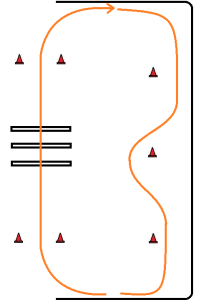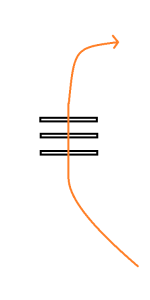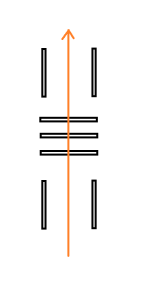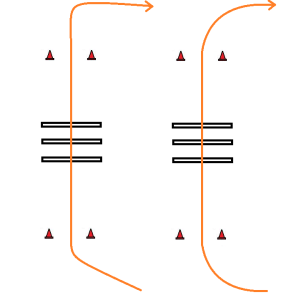Once my riders can trot 1 lap around the arena independently and switch directions across the diagonal, I find it’s time to come off the rail. Otherwise they get bored, they start to wander, so their horses start to wander, or their horses decide it’s a better idea to hang out with the instructor and leader than stay on the track. Here are some things I like to do with them.
Usually first I like to use 3 weaving cones to come off the rail then go back on. This is usually pretty easy for them, just the turns come faster because they’re trotting!
Then I add trot poles down the center line.
Sometimes I don’t use any other aids with the trot poles.
Their path usually ends up looking something like this.
All that work staying on the rail goes out the window.
But I don’t blame them – if you think about it, organizing your horse, looking ahead, turning at the right time, straightening back out, then staying on as your horse trots extra big over poles, and then figuring out what to do or where to go afterward – that’s a lot! This is such a great lesson in what is “straight” and planning ahead and coordinating aids.
So I’ll start with guide poles, to figure out what straight is.
Then I’ll switch to cones to work on when to turn, letting them keep the straightness without guide poles.
After the first attempt looking like something on the left, we talk about when to turn and how to make them smooth, especially if their horse tends to stop trotting if the turns are too narrow.
Lastly the guide cones get removed, so there’s no visual cues at all.
Often when we’re doing the trot poles we stop with the weaving cones, to focus on one exercise at a time. Once we get the trot poles I’ll add them back in for the whole pattern in the first pic.
I’ve really enjoyed using these simple exercises with my more advanced riders lately. Each rider and horse combo have something different to work on, and their parents are impressed because it looks hard. But mostly these patterns offer so many great things to work on!
Enjoy!
****************
Note: This is not professional advice, this is a blog. I am not liable for what you do with or how you use this information. The activities explained in this blog may not be fit for every rider, riding instructor, or riding center depending on their current condition and resources. Use your best personal judgment!



